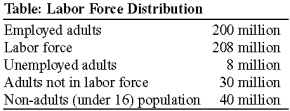A) a marginally attached worker.
B) a discouraged worker.
C) underemployed.
D) unemployed.
Correct Answer

verified
Correct Answer
verified
Multiple Choice
If the actual unemployment rate is 7% and the cyclical unemployment rate is 2%, then the natural rate of unemployment is:
A) 2%.
B) 5%.
C) 7%.
D) 9%.
Correct Answer

verified
Correct Answer
verified
Multiple Choice
Deflation is a:
A) decrease in unemployment.
B) decreasing aggregate price level.
C) decline in wages.
D) recession.
Correct Answer

verified
Correct Answer
verified
Multiple Choice
Structural unemployment consists of people who are unemployed because of:
A) temporary changes in jobs.
B) there being more labor demanded than there is labor supplied.
C) the time it takes for employers and workers to find each other.
D) there being more job hunters than there are jobs.
Correct Answer

verified
Correct Answer
verified
True/False
If the U.S. dollar were replaced with a "new dollar" at an exchange rate of 1 new dollar for 4 old dollars, then an hourly wage of $12 would become an hourly wage of 3 new dollars.
Correct Answer

verified
Correct Answer
verified
Multiple Choice
A binding minimum wage in a labor market is set _____ the equilibrium wage and causes a _____ of labor.
A) below; surplus
B) below; shortage
C) above; surplus
D) above; shortage
Correct Answer

verified
Correct Answer
verified
Multiple Choice
The percentage of the labor force that is unemployed is the:
A) labor force participation rate.
B) employment ratio.
C) unemployment rate.
D) natural employment rate.
Correct Answer

verified
Correct Answer
verified
Multiple Choice
The _____ interest rate _____.
A) nominal; can be negative
B) real; cannot be negative
C) real; can only be positive
D) real; can be zero, positive, or negative
Correct Answer

verified
Correct Answer
verified
Multiple Choice
Use the following to answer questions:  -(Table: Labor Force Data) Use Table: Labor Force Distribution. The unemployment rate is _____%.
-(Table: Labor Force Data) Use Table: Labor Force Distribution. The unemployment rate is _____%.
A) 3.85
B) 10
C) 4.55
D) 6.75
Correct Answer

verified
Correct Answer
verified
Multiple Choice
Jim has a part-time job. He would prefer to have a full-time job but has been unable to find one. Jim is classified as:
A) a discouraged worker.
B) underemployed.
C) unemployed.
D) out of the labor force.
Correct Answer

verified
Correct Answer
verified
Multiple Choice
The rate of unemployment is found by dividing the:
A) number of people looking for work by the population.
B) number of people not working but looking for work by the sum of the number of people not working but looking for work and the number of people employed.
C) labor force by the number of people looking for work.
D) unemployed and discouraged workers by the labor force.
Correct Answer

verified
Correct Answer
verified
Multiple Choice
Unanticipated inflation:
A) increases the value of money.
B) decreases uncertainty about the future.
C) reduces the real value of debt.
D) helps lenders.
Correct Answer

verified
Correct Answer
verified
Multiple Choice
If Jim's income is $80,000 and the price level is 4, then Jim's real income is:
A) $20,000.
B) $320,000.
C) $84,000.
D) $80,000.
Correct Answer

verified
Correct Answer
verified
True/False
Frictional and structural unemployment are a part of the natural rate of unemployment.
Correct Answer

verified
Correct Answer
verified
Multiple Choice
Costs of inflation do NOT include _____ costs.
A) menu
B) shoe-leather
C) unit-of-account
D) efficiency-wage
Correct Answer

verified
Correct Answer
verified
Multiple Choice
Economists claim that the unemployment rate can understate the true level of unemployment because the ONLY group that is included is:
A) discouraged workers.
B) marginally attached workers.
C) underemployed workers.
D) workers without jobs who have looked for work in the past four weeks.
Correct Answer

verified
Correct Answer
verified
True/False
Since 1960, the price level in the United States has decreased in most years.
Correct Answer

verified
Correct Answer
verified
True/False
If the labor force becomes younger, the natural rate of unemployment will fall.
Correct Answer

verified
Correct Answer
verified
True/False
The severe inflation in Israel during the mid-1980s was due to a war, an unstable government, and civil unrest in the country.
Correct Answer

verified
Correct Answer
verified
Multiple Choice
Last week, Stephanie quit her job as a copywriter at an advertising agency. She has spent the past few days browsing the help wanted ads but hasn't found anything that matches her skills. Stephanie is BEST classified as:
A) structurally unemployed.
B) frictionally unemployed.
C) a discouraged worker.
D) out of the labor force.
Correct Answer

verified
Correct Answer
verified
Showing 81 - 100 of 300
Related Exams